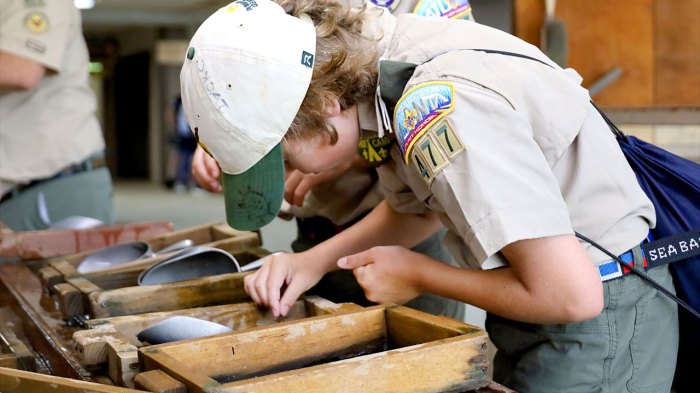Day Trip to a Mine Gives Scouts a Golden Opportunity for Fun

Maybe -— just maybe —- a valuable golden nugget is hiding in this bucket of sediment, Rocco Koekemoer Jr. thought.
The bucket was emptied into a large water trough. Rocco grabbed a pan, dipped it through the water and scooped up some sand. He swished the water around, filtering out the sediment as he searched for glittery gold.
Nope, no nuggets. But he did unearth gold flakes.

Sharanya Kar Bhowmik (left) and Ankita Daniel pan for gold flakes in water-filled troughs. Most Scouts found a little bit to take home.
“You’d only get small pieces,” the 13-year-old Second Class Scout says. “It was maybe two cents’ worth.”
Rocco and his fellow Scouts might not have left the Consolidated Gold Mine much richer, but they did take home a lot of fun memories.
RUSHING TO DAHLONEGA
The most famous gold rush in American history happened in California in the mid-1800s. But the West Coast wasn’t the first place people dug for gold. In 1829, about 15,000 people flocked to north Georgia after a local newspaper reported the discovery of
gold. Many mined around the town of Dahlonega, which sits about 50 miles north of Dunwoody, where boys Troop 477 and girls Troop 1919 are from.

Carter Townsend and Nick Sparks pretend to push an old mining cart down the rails. Miners used these carts to remove material from the mine.
Last July, the troops embarked on a day trip to Dahlonega, where they toured the Dahlonega Gold Museum, went underground at the Consolidated Gold Mine and tubed down the nearby Chestatee River.
“I thought it would be fun to learn about the history of gold in Georgia,” says Jack Cope, 13, a Star Scout.
TWO SIDES OF THE SAME COIN
The troops’ first stop was the gold museum, where they saw lottery machines used to assign plots of land to prospectors. The gold rush played a part in the forced displacement of Native American tribes from their land, later called the “Trail of Tears.”

Webelos Scout Victor Medel holds a steel spike as the mine tour guide explains how miners would make holes for dynamite.
The U.S. government established a mint in Dahlonega to make coins. Within two decades, it had produced $6 million in $1, $2.50, $3 and $5 pieces, some of which are on display at the museum.
“They passed around a gold coin; it was worth about $2,000,” says Sharanya Kar Bhowmik, 13, a First Class Scout. “It’s bigger than a dollar coin, and it was really heavy.”
INTO THE MINE
Next, the troops visited the gold mine. Learning about the conditions in a mine was humbling: It was cramped, dangerous and dark.
“They’d give you three candles. Our guide held one, and it was super dim. It was crazy. You couldn’t see your hand in front of you,” says Ty Morgan, 12, a Tenderfoot Scout.

Jack Cope searches for souvenirs of gold from the mine.
For miners making about $1 a day — 10 times more than an average daily salary, it was worth it. The guide also showed them mining tools and machinery, including a 100-year-old functional drill.
The tour ended with panning for gold. Everyone was able to find a little to take home in a souvenir vial.
RELAXING ON THE RIVER
After lunch, the Scouts grabbed inflatable tubes for an hour-and-a-half trip down the Chestatee River. The water felt icy cold, but they got used to it during the leisurely float.
“It was chill and fun,” says Thomas Tran, 15, a Second Class Scout. “I don’t think I’ve experienced a day trip where we stayed in one place.”

Logan Tran enjoys tubing down the Chestatee River.
Not every adventure requires a lot of traveling. You can discover fun close to home.
As Rocco says, “It’s pretty cool that we can go an hour away and see all that history and go tubing.”
Photographs courtesy of Barry Deutsch
Leave a Comment